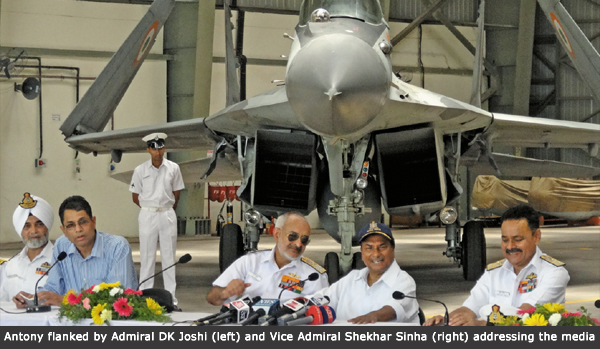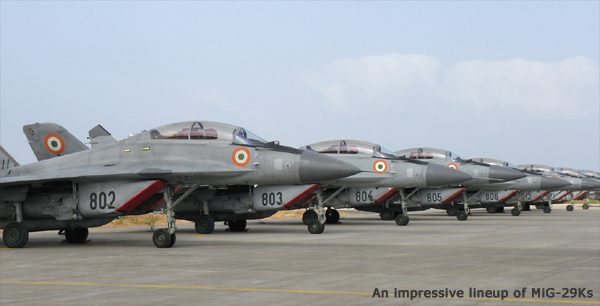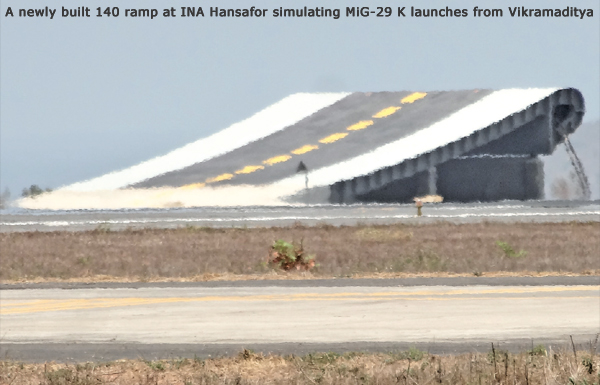|
The MiG-29Ks will board their mother ship INS
Vikramaditya when the carrier reaches the Indian
shores end-2013 after delayed delivery by Russia.
Boeing will deliver two more P-8Is this year as
per schedule while HAL will deliver the first
of the Navy’s 17 British origin Hawk advanced
trainer jets in July.
Although the aircraft are being sourced from
different countries, they are interoperable with
one another as well as with various naval ships,
ground stations and Indian Air Force (IAF) and
Army assets. While the IAF uses its own AFNET
network, the Navy uses NEWN (Navy Enterprise Wide
Network), the oldest connectivity asset among
the three Services.
The Navy’s senior most aviator, respectfully
called The Grey Eagle, Vice Admiral Shekhar Sinha,
told India
Strategic that the Indian Navy has
to maintain 24 x 7 all weather vigil in the Indian
Ocean to secure the country’s interests and also
to ensure that no state or state-sponsored terrorists
or others can stage another attack like the 2008
Mumbai terror attack anywhere on the Indian soil.
The Navy is giving due emphasis on building both
its submarine and aviation capabilities. Vice
Admiral Sinha is the Commander-in-Chief of the
Navy’s spearhead Western Command. “The Navy is
proud of all its new aircraft and looking forward
to new carrier assets,” he observed.

The flat-top INS Vikramaditya, formerly Admiral
Gorshkov of the Russian Navy, has gone through
all its tests successfully and should set sail
for India later this year. The MiG-29Ks will offer
their mother ship a grand ceremonial salute before
landing on it.
Unlike IAF’s MiG-29s, which were acquired from
1987 onwards, the MiG-29Ks of the Navy are a generation
ahead with swing role capability – the ability
to dominate the skies and attack any air, land
or sea targets. The MiG-29K flies at twice the
speed of sound (about 2000 km/hour), can pull
up to 8g (8 times the force of gravity), refuel
midair, and climb to 65,000 feet (about 11 km).
Russia has delivered some 20 of the 45 aircraft
since 2010 and the first squadron has done more
than 2,500 hours of flying already in training
and operational sorties over the Indian Ocean
on both India’s East and West coasts. The aircraft
are equipped with rockets, R-73 and Kh-35 missiles,
Israeli Elta’s Airborne Self Protection Jammer
(ASPJ) pod and Phazotron ZHUK-E radars. The weapons
package was displayed during the commissioning
ceremony, attended by top present and past naval
aviators including Admiral RH Tahiliani, who was
the first Indian Navy officer to do a carrier
landing some 50 years ago. Admiral Arun Prakash,
another aviator who headed the Navy, was also
among the luminaries invited to the inspiring
ceremony.

Pilots of the Goa based MiG-29K squadron, appropriately
named as the 303 Black Panthers – 303 being the
caliber of the good old rifle cartridge which
revolutionised ballistics in the 19th century
– are doing routine training for carrier landing
and takeoff at the INS Hansa here, where a 14
degree ski jump ramp has also been set up replicating
the one onboard the carrier. Squadron’s Commanding
Officer, Capt AD Theophilus, an accomplished Sea
Harrier pilot and a Qualified Flying Instructor,
proudly led the ceremonies.
Antony expressed confidence that the Squadron
will make a significant contribution in enhancing
peace and stability “in our area of operations”
and help provide “effective safeguards for unhindered
economic development” of India and other friendly
nations in the Indian Ocean Region, pointing out
the cooperative reach of the Indian Navy.
He also said that the Indian armed forces needed
to build technological edge over potential adversaries
and that the Government was mindful of what needed
to be done in this perspective, given the fact
that the security scenario in the region is changing
fast.
Antony also disclosed that India’s first Indigenous
Aircraft Carrier (IAC-1) would be launched in
August in Kochi, where it is currently under construction.
It will take a couple of years though to make
it operational.
The 45 MiG-29Ks are designated for INS Vikramaditya
and IAC-1. Rear Admiral DK Sudan, Assistant Chief
of Naval Staff (Air) or ACNS (Air), who plays
a key role in building the naval aviation capability,
described 2013 as The Year of Naval Aviation,
and observed that all plans of the Navy regarding
aviation assets “are on track.”

|